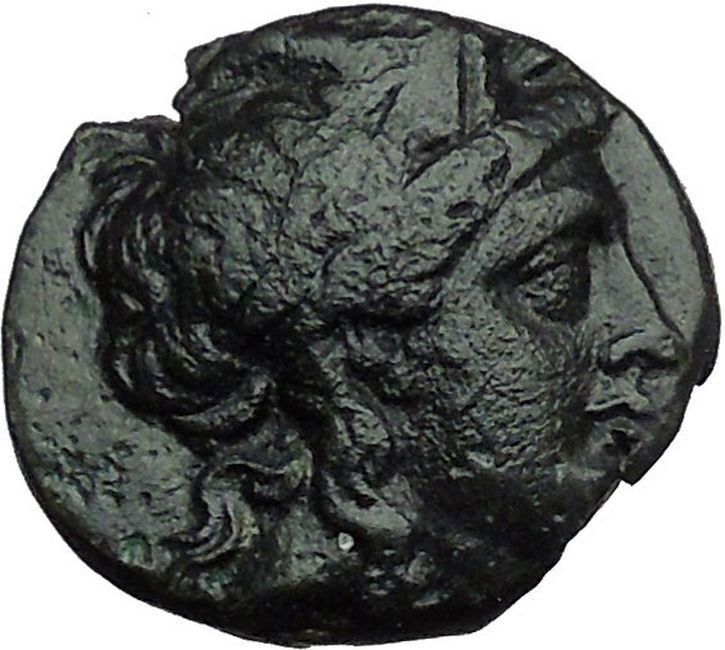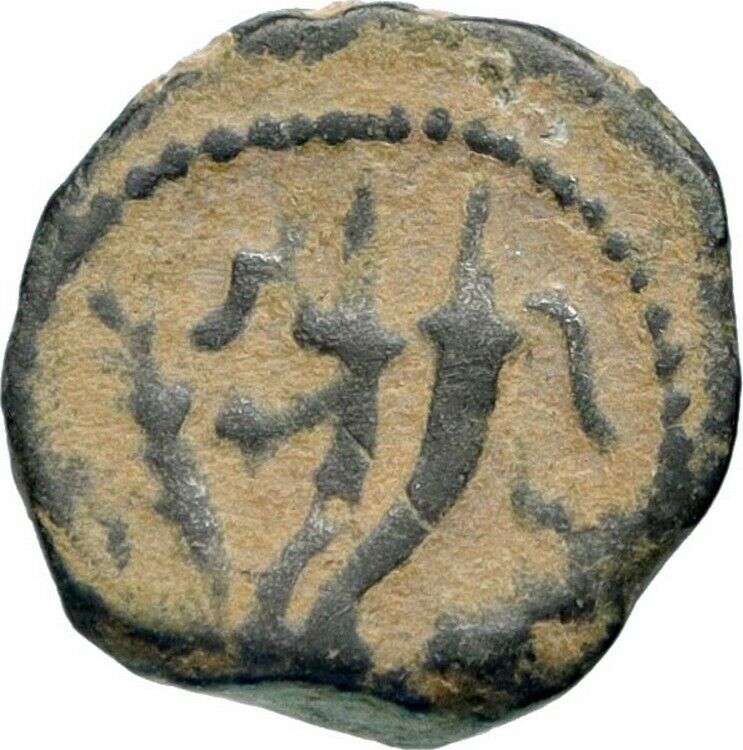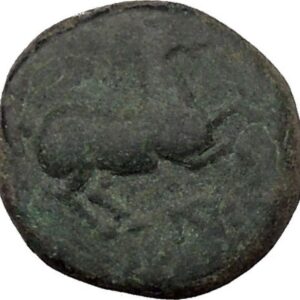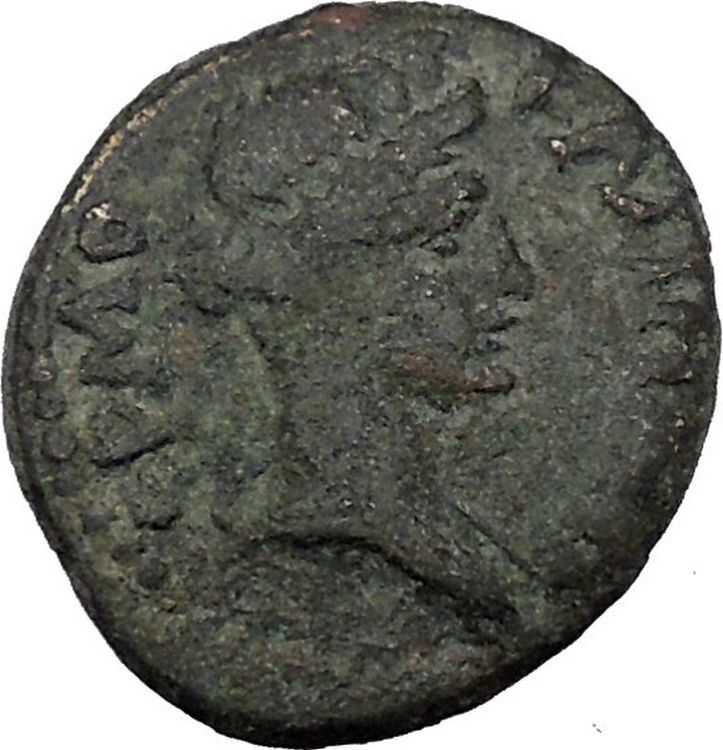|
Greek city of
Tarsos
in
Cilicia
Bronze 14mm (2.92 grams) Struck circa 164-50 B.C.
Reference: BMC 21,184,134; Levante 975
Club with monograms in left and right fields; all within oak wreath.
TAPΣEΩN, Zeus enthroned left, holding Nike and scepter.
The first city of Cilicia and
capital of the native rulers down to circa 400 B.C., Tarsus was situated in the
fertile eastern plain on the river Kydnos, about 12 miles from the sea. In the
4th century, until the arrival of Alexander in 333 B.C., Tarsus was the chief
mint of the Persian satraps. Eventually, in the 1st century B.C., it became the
capital of the Roman province of Cilicia.
You are bidding on the exact
item pictured, provided with a Certificate of Authenticity and Lifetime
Guarantee of Authenticity.
In the
ancient Greek
religion, Zeus was the
“Father of Gods and men” (πατὴρ ἀνδρῶν τε θεῶν
τε)
who ruled the Olympians of
Mount Olympus
as a father ruled the family. He was the
god of sky
and
thunder
in
Greek mythology
.
His
Roman
counterpart is
Jupiter
and
Etruscan
counterpart is Tinia
.![The Jupiter de Smyrne, discovered in Smyrna in 1680[1]](https://upload.wikimedia.org/wikipedia/commons/thumb/c/c8/Jupiter_Smyrna_Louvre_Ma13.jpg/200px-Jupiter_Smyrna_Louvre_Ma13.jpg)
Zeus was the child of
Cronus
and
Rhea
,
and the youngest of his siblings. In most traditions he was married to
Hera, although, at the
oracle of Dodona
,
his consort was
Dione
:
according to the Iliad
,
he is the father of
Aphrodite
by Dione. He is known for his erotic escapades. These resulted in many godly and
heroic offspring, including
Athena
,
Apollo
and Artemis
,
Hermes
,
Persephone
(by Demeter
),
Dionysus
,
Perseus
,
Heracles
,
Helen of Troy
,
Minos
,
and the Muses
(by Mnemosyne
);
by Hera, he is usually said to have fathered
Ares,
Hebe
and Hephaestus
.
As
Walter Burkert
points out in his book, Greek Religion, “Even the gods who are not his
natural children address him as Father, and all the gods rise in his presence.”
For the Greeks, he was the
King of the Gods
,
who oversaw the universe. As
Pausanias
observed, “That Zeus is king in heaven is a saying common to all men”. In
Hesiod’s Theogony
Zeus assigns the various gods their roles. In the Homeric Hymns he is
referred to as the chieftain of the gods.
His symbols are the
thunderbolt
,
eagle
,
bull
,
and oak
.
In addition to his Indo-European inheritance, the classical “cloud-gatherer”
also derives certain iconographic traits from the cultures of the
Ancient Near East
,
such as the
scepter
.
Zeus is frequently depicted by Greek artists in one of two poses: standing,
striding forward, with a thunderbolt leveled in his raised right hand, or seated
in majesty.
Tarsus (Greek:
Ταρσός,
Armenian
: Տարսոն, Darson) is a
historical city
in
south-central Turkey
, 20 km inland from
Mediterranean Sea
. It is part of
Adana-Mersin Metropolitan Area
, fourth largest
metropolitan area
in
Turkey
with a
population of 2.75 million. Tarsus is an administrative district in
Mersin Province
and lies in the core of
Çukurova
, a
geographical, economical and cultural region.
With a history going back over 9,000 years Tarsus has long been an important
stop for traders, a focal point of many civilisations including the
Ancient Romans
when Tarsus was capital of the province of
Cilicia
,
scene of the first meeting between
Mark
Antony
and
Cleopatra
and birthplace of
Saint Paul
.
//
Geography
Located on the mouth of the Tarsus Çay (Cydnus),
which empties into the
Mediterranean Sea
, Tarsus is a junction point of land and sea routes
connecting the Cilician
plain (today called
Çukurova
),
central Anatolia
and the Mediterranean sea. The climate is typical of the
Mediterranean
region, summers very very hot, winters chilly and damp.
Tarsus has a long history of commerce and is still a commercial centre today,
trading in the produce of the fertile Çukurova plain; also Tarsus is a thriving
industrial centre refining and processing that produce same for export.
Industries include agricultural machinery, spare parts, textiles,
fruit-processing, brick building and ceramics.
Agriculture is an important source of income, half of the land area in the
district is farmland (1,050 km²) and most of the remainder is forest and
orchard. The farmland is mostly well-irrigated, fertilised and managed with the
latest equipment.
Etymology
The ancient name is Tarsos, (Greek:
Ταρσός) possibly derived from a
pagan god, Tarku; at other times the city was named Tarsisi;
Antiochia on the Cydnus (Greek:
Αντιόχεια του Κύδνου,
Latin
:
Antiochia ad Cydnum); and Juliopolis. [Տարսոն, Darson in
Western Armenian
and Tarson in
Eastern Armenian
] . The
Hittites
referred to Tarsus as Tarsa.[1]
Pegasus
the winged horse was a mortal. Because of his faithful service to Zeus the Greek
god, he was honored with a constellation.[5] On the last day of pegasuses life,
Zeus transformed him into a constellation, then a single feather fell to the
earth near the city of Tarsus {Ταρσός} in Greek.
History
Antiquity
Foundation
and prehistory
Excavation of the mound of Gözlükule reveals that the prehistorical
development of Tarsus reaches back to the
Neolithic Period
and continues unbroken through
Chalcolithic
and
Early Bronze Ages
.
The settlement was located at the crossing of several important trade routes,
linking Anatolia
to Syria
and beyond. Because the ruins are covered by the modern city, archaeology has
barely touched the ancient city. The city may have been of
Semitic
origin; it is mentioned as Tarsisi in the campaigns of
Esarhaddon
,
as well as several times in the records of
Shalmaneser I
and
Sennacherib
. A Greek legend connects it with the memory of
Sardanapalus
(Ashurbanipal), still preserved in the Dunuk-Tach, called ‘tomb
of Sardanapalus’, a monument of unknown origin.
Stephanus of Byzantium
quotes
Athenodorus of Tarsus
as relating another legend:
|
“
|
Anchiale, daughter of
Iapetus
, founded Anchiale (a city near Tarsus): her son was
Cydnus
, who gave his name to the river at Tarsus: the son of Cydnus
was Parthenius, from whom the city was called Parthenia: afterwards the
name was changed to Tarsus.
|
”
|
Much of this legend of the foundation of Tarsus, however, appeared in the
Roman era, and none of it is reliable. The geographer
Strabo
states
that Tarsus was founded by people from
Argos
who were
exploring this coast. Another legend states that the winged horse
Pegasus
was
lost and landed here, hurting his foot, and thus the city was named tar-sos
(the sole of the foot). Other candidates for legendary founder of the
city include the hero
Perseus
and
Triptolemus
son of the earth-goddess
Demeter
,
doubtless because the countryside around Tarsus is excellent farmland. Later the
coinage of Tarsus bore the image of
Hercules
,
due to yet another tale in which the hero was held prisoner here by the local
god Sandon
.
Tarsus has been suggested as a possible identification of the biblical
Tarshish
,
where the prophet Jonah
wanted to flee, but
Tartessos
in Spain is a more likely identification for this. (See further[2])
Early
antiquity, Greece and Persia
In historical times, the city was first ruled by the
Hittites
,
followed by Assyria
, and then the
Persian Empire
. Tarsus was the seat of a Persian
satrapy
from
400 BC onward. Indeed,
Xenophon
records that in 401 BC, when
Cyrus the Younger
marched against
Babylon
, the
city was governed by King
Syennesis
in the name of the Persian monarch.
Alexander the Great
passed through with his armies in 333 BC and nearly met
his death here after a bath in the Cydnus. By this time Tarsus was already
largely influenced by
Greek language and culture
, and as part of the
Seleucid Empire
it became more and more
hellenized
. Strabo praises the cultural level of Tarsus in this period with
its philosophers, poets and linguists. The schools of Tarsus rivaled
Athens
and
Alexandria
.
2
Maccabees
(4:30) records its revolt in about 171 BC against
Antiochus IV Epiphanes
, who had renamed the town Antiochia on the Cydnus.
In his time the library of Tarsus held 200,000 books, including a huge
collection of scientific works. The name didn’t last, however, due to the
confusion of so many cities named Antioch.
Rome

Oscillum depicting a couple kissing.
Terracotta
figurine made in Tarsus,
Roman Era
Pompey
subjected Tarsus to Rome, and it became capital of the Roman province of
Cilicia
, the
metropolis where the governor resided. In 66 BC, the inhabitants received Roman
citizenship. To flatter
Julius Caesar
, for a time it took the name Juliopolis. It was also
here that
Cleopatra
and
Mark
Antony
met and was the scene of the celebrated feasts they gave during the
construction of their fleet (41 BC).
When the province of Cilicia was divided, Tarsus remained the civil and
religious metropolis of Cilicia Prima, and was a grand city with palaces,
marketplaces, roads and bridges, baths, fountains and waterworks, a gymnasium on
the banks of the
Cydnus
, and a stadium. Tarsus was later eclipsed by nearby
Adana
, but
remained important as a port and shipyard. Several Roman emperors were interred
here:
Marcus Claudius Tacitus
,
Maximinus
, and
Julian the Apostate
, who planned to move his capital here from Antioch if he
returned from his Persian expedition.[3]
Christianity
Tarsus was the birthplace of
Saint Paul
(Acts
9:11; 21:39; 22:3), who returned here after his conversion (Acts 9:30). From
here Barnabas
retrieved him to help with the work in Syrian Antioch (Acts 11:25). Already by
this time a Christian
community probably existed, although the first recorded bishop,
Helenus
, dates only from the third century; Helenus visited
Antioch
several times in connection with the dispute concerning
Paul of Samosata
. Later
bishops of Tarsus
included
Lupus
, present at the
Council of Ancyra
in 314; Theodorus, at the
Council of Nicaea
in 325; Helladius, who was condemned at the
Council of Ephesus
and who appealed to the bishop of Rome in 433; above all
the celebrated exegete Diodorus, teacher of
Theodore of Mopsuestia
and consequently one of the fathers of
Nestorianism
.[4]
From the sixth century the metropolitan see of Tarsus had seven suffragan
bishoprics;[5]
the
Ecumenical Patriarchate of Constantinople
archdiocese is again mentioned in
the tenth century ([6]),
and has existed down to the present day, part of the
Patriarchate of Antioch
.
Owing to the importance of Tarsus, many martyrs were put to death here, among
them being
Saint Pelagia
,
Saint Boniface
,
Saint Marinus
,
Saint Diomedes
,
Saint Quiricus and Saint Julitta
.
At about the end of the tenth century, the Armenians established a diocese of
their rite, which still exists;
Saint Nerses of Lambroun
was its most distinguished representative in the
twelfth century.
A cave in Tarsus is one of a number of places claiming to be the location of
the legend of the
Seven Sleepers
, common to Christianity and Islam.
Islam
and beyond
The Tarsus region was annexed by the Forces of
Rashidun Caliphate
under the command of
Khalid ibn Walid
in 637. Tarsus was on the edge of the de facto border with
the Byzantine empire in this period of the
Taurus Mountains
range separating the
Armeniac
and
Anatolic
themes
from Cilicia, Syria and northern Iraq. Tarsus was near the
strategically important
Cilician Gates
which passed through the Taurus Mountains as well as access
to the Mediterranean Sea which was used for both land and naval operations
further in the Byzantine territory. While the region was lost by the Byzantine
Emperor Heraclius
in 637, it is unclear when the city was permanently
occupied by the Arabs as sources indicate the city was garrisoned and retaken
multiple times until the 9th century.[7]
According to the Arabic geographer
Ibn Hawqal
and the accounts of Arab historian Abu Amr Al-Tarsusi, Tarsus was a stronghold
of Muslim forces with thousands of volunteers from across the Islamic world
coming to fight in jihad against the Byzantine Empire. The city was a base of
operations for the regular summer raids (ṣawāʿif) into Byzantine lands
through the Cilician Gates when the mountain snows had melted and passage was
possible. Later the city was used in defense of the frontier in response to a
resurgent Byzantine empire in the mid-10th century.[8]
The city was lost in 965, when
Nicephorus Phocas
returned it to the
Byzantine Empire
for nearly a century. The area was retaken by the
Seljuk Turks
, recaptured in 1097 during the
Crusades
and then disputed between Latins, Greeks, and Armenians of the
Armenian Kingdom of Cilicia
(Kingdom of Lesser Armenia); these last became
definitively masters until about 1360, when it was captured by the
Ramazanoğlu
Turks. Finally, the area was brought under the control of the
Ottomans
by Selim I
in 1517.
In the Middle Ages Tarsus was renowned throughout the Middle East; a number
of Arab writers praised it as a beautiful and well-defended city, its walls
being in two layers with five gates and earthworks outside, surrounded by rich
farmland, watered by the river and the lake. By 1671 the traveller
Evliya Çelebi
records “a city on the plain, an hour from the sea,
surrounded by strong walls two-storeys high, moated on all sides, with three
distinct neighbourhoods inside the walls”.
Despite its excellent defences, Tarsus was captured from the Ottomans in 1832
by the
Mamluks
of
Ibrahim Pasha of Egypt
, son of
Muhammad Ali
, and for 8 years remained in the hands of the Egyptians, who
began growing cotton on the surrounding plain. Upon the return of the Ottomans
this cotton drove a substantial growth in the economy of the area, due to
increased world demand for the crop during shortages caused by the
U.S. Civil War
. A new road was built to the port in
Mersin
and the
city of Tarsus grew and thrived. Still today many large houses in the city stand
as reminders of the wealth generated during this period. However after being a
port for 3,000 years, by the end of the 19th century neglect resulted in Tarsus
no longer having access to the sea, and the delta became a swamp. At this point
Tarsus was a typical Ottoman city with communities of Muslim Turks, Christian
Greeks and Armenians
. At the founding of the
Turkish Republic
in the 1920s the swamp was drained and the River Berdan was
dammed to build Turkey’s first hydro-electric power station. Irrigation,
roadworks and a railway brought the economy of Tarsus back to life, with new
factories, particularly producing textiles.
Life
in Tarsus today
Tarsus has slightly more in the way of culture (cinema, theatre, museums)
than most Turkish country towns, but in many ways still has a small town feel;
people walk in the road rather than on the pavements. Predictably, the people of
the mountain forests in the hinterland have an even quieter rural existence.
The local cuisine includes:
hummus
;
şalgam
(pickled turnips);
tantuni
(a sandwich of grilled meats; the tiny pizzas called “fındık
lahmacun”; and
cezerye
(a
confection made out of carrots).
Places
of interest
Tarsus has a great many ancient sites of interest, with many in need of
restoration and research. The best known include:

Church of
St. Paul
in Tarsus, (the church and the surroundings are on the
UN World Heritage
tentative list
-
Cleopatra Gate – to the west of the city, the only ancient city gate
still standing, where Anthony and Cleopatra entered the city in 41 BC,
though the “restoration” of this structure has involved covering much of it
over with shiny new stone (see
[2]
for a picture of the gate before the work was done).
-
The Roman bridge of Justinian over the Berdan River. Still in good
condition.
-
Tarsus Museum – contains lots of ancient coins and a severed mummified
arm.
Sites of religious interest and pilgrimage:
-
The church and well of St Paul.
-
The tomb of the
Seven Sleepers
, busy place of pilgrimage for Muslims today.
-
The mosque said to be the burial place of the
Prophet Daniel
.
From the Turkish era:
-
The old baths; the dark brown spots on the white marble walls are said
to be the bloodstains of
Shah Meran
, the legendary Snake King who was killed in an ambush in the
baths.
-
Tarsus American College
; founded in the Ottoman period, still active
today.
-
“Nusret
(Nusrat)” the
minelayer
used to defend the straits before the
Battle of Gallipoli
is being restored in Tarsus; it is to be part of a
memorial park to those lost in the fighting.
Places of natural beauty include:
-
Tarsus Waterfall; since the construction of the Berdan dam the water of
the Tarsus river has been distributed in canals for irrigation, with the
result that the waterfall can now be seen only in seasons of very heavy
rainfall.
Notable
residentss
-
Antipater
,
Stoic
philosopher
-
Caliph
Al-Ma’mun
died near Tarsus
-
Journalist
Oral Çalışlar
was born in Tarsus.
-
Chrysippus
, Stoic philosopher
-
Cleopatra
-
Lokman
the Physician
-
Mark Antony
-
Saint
Nerses of Lambron
, Archbishop of Tarsus in the
Armenian Kingdom of Cilicia
-
Paul the Apostle
(Saul
of Tarsus), Christian apostle, missionary, martyr, and saint, was born
here and returned for a brief period later in life.
-
Saint
Theodore of Tarsus
,
Archbishop of Canterbury
.
-
Tarsus is one of a number of cities that claims to be the burial place
of
Bilal ibn Rabah
, first
muezzin
,
or caller to prayer, in Islam.
-
Tarsus Idman Yurdu
is the local football team.
|





![The Jupiter de Smyrne, discovered in Smyrna in 1680[1]](https://upload.wikimedia.org/wikipedia/commons/thumb/c/c8/Jupiter_Smyrna_Louvre_Ma13.jpg/200px-Jupiter_Smyrna_Louvre_Ma13.jpg)





